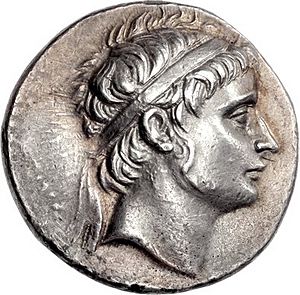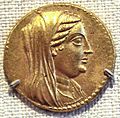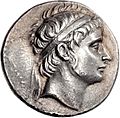Ptolemy III Euergetes facts for kids
Quick facts for kids Ptolemy III Euergetes |
|
|---|---|
| Greek: Πτολεμαῖος Εὐεργέτης | |
 |
|
| King of the Ptolemaic Kingdom Pharaoh of Egypt |
|
| Reign | 28 January 246 – November/December 222 BC (Ptolemaic dynasty) |
| Predecessor | Ptolemy II |
| Successor | Ptolemy IV |
| Consort | Berenice II |
| Children | |
| Father | Ptolemy II |
| Mother | Arsinoe I |
| Born | c. 280 BC Kos or Egypt |
| Died | November/December 222 BC (aged c. 58) |
| Burial | Alexandria |
Ptolemy III Euergetes (born around 280 BC – died November/December 222 BC) was the third pharaoh of the Ptolemaic dynasty in Egypt. He ruled from 246 to 222 BC. His nickname, "Euergetes," means "the Benefactor." During his time as king, the Ptolemaic Kingdom became very strong, both militarily and economically. This growth had started under his father, Ptolemy II Philadelphus.
Ptolemy III was the oldest son of Ptolemy II and Arsinoe I. When he was young, his mother faced problems, and he was removed from the line of succession. However, he was later made heir again in the late 250s BC. He became king without any trouble in 246 BC after his father died. When he became king, Ptolemy III married Berenice II, who was the queen of Cyrenaica. This marriage brought her land into the Ptolemaic kingdom.
In the Third Syrian War (246–241 BC), Ptolemy III attacked the Seleucid Empire. He won many battles but had to stop his campaign because of a rebellion in Egypt. After this uprising, Ptolemy worked closely with the Egyptian priests. This partnership was made official in the Canopus decree of 238 BC. This set a pattern for how the Ptolemaic kings would rule Egypt for the rest of their dynasty. In the Aegean, Ptolemy III's navy was defeated by the Antigonids at the Battle of Andros around 246 BC. Despite this, he continued to support their enemies in mainland Greece with money. After his death, Ptolemy III was followed by his oldest son, Ptolemy IV.
Contents
Early Life of Ptolemy III
Ptolemy III was born around 280 BC. He was the oldest son of Ptolemy II and his first wife, Arsinoe I. His father became the co-ruler of Egypt in 284 BC and the sole ruler in 282 BC.
Around 279 BC, his father's sister, Arsinoe II, returned to Egypt. She had been married to King Lysimachus of Thrace. Soon, a conflict started between Ptolemy III's mother, Arsinoe I, and his aunt, Arsinoe II. After 275 BC, Arsinoe I was accused of plotting against the king and was sent away to Coptos. When Ptolemy II married Arsinoe II around 273/2 BC, Arsinoe II had completely won this conflict.
Because their mother was disgraced, Ptolemy III and his two siblings were removed from the line of succession. This might explain why Ptolemy III was raised on Thera in the Aegean Sea, instead of in Egypt. One of his teachers was the famous poet and scholar Apollonius of Rhodes, who later became the head of the Library of Alexandria.
In the late 250s BC, Ptolemy II arranged for Ptolemy III to marry Berenice. She was the only child of Ptolemy II's half-brother, King Magas of Cyrene. This marriage showed that Ptolemy III was now the chosen heir to the throne. When his father died, Ptolemy III became king on January 28, 246 BC.
Ptolemy III's Reign as Pharaoh
Reuniting Cyrenaica with Egypt

Cyrene was the first land outside Egypt that the Ptolemies controlled. However, King Magas of Cyrenaica had rebelled against Ptolemy II in 276 BC. The plan was for Ptolemy III to marry Berenice, Magas's daughter, to bring Cyrene back under Egyptian rule after Magas died.
But when Magas died in 250 BC, Berenice's mother, Apame, did not want to follow the agreement. Instead, she invited a prince named Demetrius the Fair to Cyrene to marry Berenice. Demetrius took control of the city with Apame's help. However, Berenice had him killed. After this, a republican government ruled Cyrene for four years.
Ptolemy III and Berenice finally married when Ptolemy III became king in 246 BC. Ptolemaic rule over Cyrene was strongly re-established. Two new port cities were built: Ptolemais and Berenice (now Tolmeita and Benghazi). These cities were named after the royal couple. The cities of Cyrenaica were joined together in a League. The king oversaw this League, balancing the cities' desire for freedom with Ptolemaic control.
The Third Syrian War (246–241 BC)
In July 246 BC, Antiochus II, the king of the Seleucid Empire, died suddenly. He had a son, Seleucus II, from his first wife, Laodice I. But in 253 BC, Antiochus II had agreed to divorce Laodice and marry Ptolemy III's sister, Berenice. Antiochus II and Berenice had a young son named Antiochus.
A fight over who would be the next king started right after Antiochus II's death. Ptolemy III quickly invaded Syria to support his sister and her son. This started the Third Syrian War, also known as the Laodicean War.
Ptolemy III himself wrote about the start of this war. This account is found on the Gurob papyrus. When the war began, Laodice I and Seleucus II were in western Asia Minor. Queen Berenice was in Antioch. Berenice quickly took control of Cilicia to stop Laodice I from entering Syria. Meanwhile, Ptolemy III marched along the coast of the Levant. He met very little resistance. The cities of Seleucia and Antioch surrendered to him easily in late autumn. In Antioch, Ptolemy III went to the royal palace to plan his next moves with Berenice. But he found out that she and her young son had been murdered.
Instead of giving up, Ptolemy III continued his campaign through Syria and into Mesopotamia. He conquered Babylon at the end of 246 or beginning of 245 BC. Because of this success, he might have been crowned 'Great King' of Asia. In early 245 BC, he appointed a governor for the land 'on the other side' of the Euphrates River. This showed he planned to keep this region as part of the Ptolemaic kingdom.
However, Ptolemy III then learned that a revolt had started in Egypt. He had to return home to stop it. By July 245 BC, the Seleucids had taken back Mesopotamia. This Egyptian revolt was important because it was the first of many native Egyptian uprisings that would cause problems for Egypt for the next century. One reason for this revolt was the high taxes Ptolemy III put on the people of Egypt to pay for his war in Syria. Also, records show that the Nile river's annual inundation failed in 245 BC, leading to a famine. Studies suggest this was due to changes in monsoon patterns, possibly caused by a volcanic eruption in 247 BC.
After returning to Egypt and stopping the revolt, Ptolemy III worked to present himself as a victorious king. He did this in both Egyptian and Greek ways. Official messages, like an inscription in Adulis, greatly exaggerated his conquests. They even claimed he had conquered Bactria. In 243 BC, Ptolemy III and his wife Berenice II were added to the Ptolemaic state religion. They were worshipped as the Theoi Euergetai (Benefactor Gods). This was to honor him for bringing back statues to Egypt that the Persians had taken from Seleucid lands.
There might have also been fighting in the Aegean Sea during this war. A general named Ptolemy Andromachou captured Ephesus from the Seleucids in 246 BC. Around 245 BC, he fought a sea-battle at Andros against King Antigonus II of Macedon. The Ptolemaic forces were defeated. He then seems to have led an invasion of Thrace. Ptolemaic forces controlled Maroneia and Aenus in 243 BC. Ptolemy Andromachou was later killed in Ephesus by Thracian soldiers.
The only other known action from the war was some fighting near Damascus in 242 BC. Soon after, in 241 BC, Ptolemy made peace with the Seleucids. He kept all the land he had conquered in Asia Minor and northern Syria. Nearly the entire Mediterranean coast, from Maroneia in Thrace to the Syrtis in Libya, was now under Ptolemaic control. One of the most important gains was Seleucia Pieria, the port of Antioch. Losing this port was a big economic and logistical setback for the Seleucids.
Later Years of Ptolemy III's Rule (241–222 BC)
After the Third Syrian War ended, Ptolemy III stopped direct military action in Seleucid lands. However, he continued to secretly give money to those who opposed Seleucus II. From 241 BC, this included Antiochus Hierax, Seleucus II's younger brother, who rebelled and formed his own kingdom in Asia Minor. Ptolemy III only sent troops to help him when some Galatian soldiers rebelled against Antiochus. But he likely supported him more quietly throughout his conflict with Seleucus II.
He also supported Attalus I, the ruler of Pergamum. Attalus used this civil conflict to expand his lands in northwestern Asia Minor. In 223 BC, when the Seleucid general Achaeus was sent to take back the lands Attalus had gained, Ptolemy III sent his son Magas with soldiers to help Attalus. However, they could not prevent Attalus's defeat.
Ptolemy III continued his father's policy of being against Macedonia. This likely involved direct fighting with Antigonus II during the Third Syrian War. But after the defeat at Andros around 245 BC, Ptolemy III seemed to go back to indirect opposition. He funded enemies of the Antigonids in mainland Greece. The most important of these was the Achaian League. This was a group of Greek city-states in the Peloponnese that were united against Macedon. From 243 BC, Ptolemy III was the official leader (hegemon) and military commander of the League. He gave them a yearly payment. After 240 BC, Ptolemy also made an alliance with the Aetolian League in northwest Greece. From 238 to 234 BC, these two leagues fought the Demetrian War against Macedon with Ptolemaic money.
However, in 229 BC, the Cleomenean War (229–222 BC) started between the Achaian League and Cleomenes III of Sparta. Because of this, in 226 BC, Aratos of Sicyon, the leader of the Achaian League, made an alliance with the Macedonian king Antigonus III. Ptolemy III immediately stopped his support for the Achaian League and instead sent his money to Sparta. Most of the other Greek states came under Macedonian control in 224 BC when Antigonus created the "Hellenic League." However, Aetolia and Athens remained against Macedon and strongly supported Ptolemy III. In Athens, in 224 BC, Ptolemy III received many honors to strengthen their alliance. A new tribe was named Ptolemais after him, and a new deme was named Berenicidae after Queen Berenice II. The Athenians started a state religious cult where Ptolemy III and Berenice II were worshipped as gods. This included a festival called the Ptolemaia. The main place for this cult was the Ptolemaion, which was also a gymnasium where young male citizens trained.
Cleomenes III suffered big defeats in 223 BC. Ptolemy III stopped supporting him the next year, probably because of an agreement with Antigonus. The Egyptian king seemed unwilling to send actual troops to Greece, especially as a new war with the Seleucids seemed likely. Cleomenes III was defeated and had to flee to Alexandria. Ptolemy III offered him a place to stay and promised to help him regain power. However, these promises were not kept. The Cleomenian War would be the last time the Ptolemies got involved in mainland Greece.
In November or December 222 BC, shortly after Cleomenes arrived in Egypt and Magas failed in Asia Minor, Ptolemy III died of natural causes. His son Ptolemy IV became king without any problems.
Ptolemy III's Rule and Egyptian Culture
Pharaoh's Role and Egyptian Religion

Ptolemy III continued what his ancestors had started: acting like a traditional Egyptian pharaoh. He was the first king to issue decrees written in three languages on huge stone blocks: Ancient Greek, Egyptian hieroglyphs, and demotic. Earlier decrees were only in hieroglyphs and were for single temples.
In contrast, Ptolemy III's Canopus decree came from a special meeting of all the priests of Egypt in 238 BC. This decree made several changes and showed a strong partnership between Ptolemy III as pharaoh and the Egyptian priests. This partnership lasted until the end of the Ptolemaic dynasty. In the decree, the priests praised Ptolemy III as a perfect pharaoh. They highlighted his support for the priests, his military success in defending Egypt, and his return of religious items supposedly taken by the Seleucids. They also praised his good rule, especially when he paid for a huge amount of grain to make up for a weak Nile flood. The rest of the decree made changes to the priestly groups. The decree also added a leap day to the Egyptian calendar of 365 days and changed related festivals. Ptolemy III's baby daughter Berenice died during this meeting. The stone tablet arranged for her to be made a goddess and worshipped. Other decrees would be issued by priestly meetings under Ptolemy III's successors. Famous examples include the Decree of Memphis by his son Ptolemy IV around 218 BC and the Rosetta Stone by his grandson Ptolemy V in 196 BC.
Before Ptolemy III, his grandfather Ptolemy I and father Ptolemy II had focused on worshipping Amun at Karnak in Thebes. With Ptolemy III, the focus shifted strongly to Ptah, worshipped at Memphis. Ptah's earthly form, the Apis bull, became very important in royal new year and coronation festivals. This new focus is shown in two parts of Ptolemy III's Pharaonic titles: his nomen included "Mery-Ptah" (beloved of Ptah), and his golden Horus name was "Neb khab-used mi ptah-tatenen" (Lord of the Jubilee-festivals as well as Ptah Tatjenen).
Ptolemy III paid for building projects at temples all over Egypt. The most important was the Temple of Horus at Edfu. This is one of the most beautiful ancient Egyptian temples and is now the best-preserved. The king started building it on August 23, 237 BC. Work continued for most of the Ptolemaic dynasty. The main temple was finished during Ptolemy IV's reign in 231 BC. The whole complex was only completed in 142 BC, during the reign of Ptolemy VIII. The carvings on the great pylon were finished during the reign of Ptolemy XII. Other construction work happened at many sites, including:
- Serapeum of Alexandria
- Temple of Osiris at Canopus
- Decorations on the Temple of Isis at Behbeit El Hagar, near Sebennytos
- A sacred lake in the Temple of Montu at Medamud
- The Gateway of Ptolemy III in the Temple of Khonsu and decorations on the Temple of Opet at Karnak Thebes
- Temple of Khnum at Esna
- A birth house at the Temple of Isis at Philae
Learning and Culture
Ptolemy III continued his father's support for learning and literature. The Great Library in the Musaeum was joined by a second library built in the Serapeum. It is said that he had every book unloaded at the Alexandria docks taken and copied. He would return the copies to their owners and keep the original books for the Library. The writer Galen says that Ptolemy III borrowed the official manuscripts of Aeschylus, Sophocles, and Euripides from Athens. He gave up the large deposit he paid for them to keep them for the Library instead of returning them.
The most famous scholar at Ptolemy III's court was the geographer Eratosthenes. He is known for his very accurate calculation of the circumference of the world. Other important scholars included the mathematicians Conon of Samos and Apollonius of Perge.
Red Sea Trade
Ptolemy III's reign also saw trade with other countries. In the 1930s, excavations near Port Dunford (likely the ancient Nikon) in southern Somalia found many Ptolemaic coins. Among these were 17 copper coins from the reigns of Ptolemy III to Ptolemy V.
Family of Ptolemy III
Ptolemy III married his half-cousin Berenice of Cyrene in 244/243 BC. They had several children:
| Name | Image | Born | Died | Notes |
|---|---|---|---|---|
| Arsinoe III |  |
246/5 BC | 204 BC | Married her brother Ptolemy IV in 220 BC. |
| Ptolemy IV |  |
May/June 244 BC | July/August 204 BC | Became King of Egypt from 222 to 204 BC. |
| A son | July/August 243 BC | Perhaps 221 BC | His name is unknown, possibly 'Lysimachus'. He was likely killed during a political purge in 221 BC. | |
| Alexander | September/October 242 BC | Perhaps 221 BC | He was likely killed during a political purge in 221 BC. | |
| Magas | November/December 241 BC | 221 BC | Died in his bath, ordered by Ptolemy IV. | |
| Berenice | January/February 239 BC | February/March 238 BC | Made a goddess after her death on March 7, 238 BC, by the Canopus Decree. |
Images for kids
See also
 In Spanish: Ptolomeo III para niños
In Spanish: Ptolomeo III para niños










